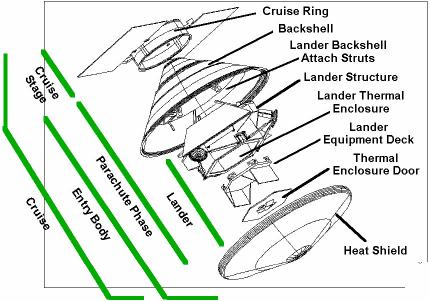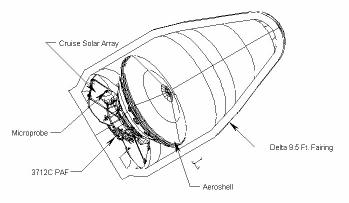
Mars Surveyor 98 Lander Configurations
LANDER SPACECRAFT
The lander spacecraft consists of a cruise stage, an aeroshell (consisting of a backshell and a heatshield), and the lander as shown in the expanded view in Figure 1. During cruise, the lander is located inside the aeroshell, which provides protects the lander during entry into the Martian atmosphere. The heatshield diameter was constrained to 2.4m (7.9 ft) to achieve a high landing altitude of 6 km (19,690 ft), which is typical in the southern part of Mars. The electronics (avionics) that control the spacecraft during cruise, entry into the Mars atmosphere and landing on its surface, and especially after landing are located inside the lander thermal enclosure mounted to the lander component deck. Because of the extreme cold temperatures on Mars (the temperature at landing is estimated as cold as -72_C(-98_F)), the avionics are located inside the thermal enclosure which provides protection for the electronics and temperature control to keep them operating at their proper temperature, generally -15_C to +10_C (-41_ F to 50_F). The cruise stage provides power from high efficiency Gallium Arsenide solar cells, and contains the star trackers and star sensors necessary for the lander to know its location while on its way to Mars, two solid-state power amplifiers and antennas for communication with Earth during cruise, and the two New Millennium Program microprobes (i.e., micropenetrators located underneath the cruise solar arrays and protected by multi-layer insulation (MLI) during cruise, see Figure 3 for their location).
Figure 1. 1998 Mars Surveyor Flight System Components
(Microprobes not shown)
For launch the lander flight system is upside down with the cruise stage attached to the Delta launch vehicle upper stage (See Figure 2), Because the avionics are located inside the lander thermal enclosure, which is designed for -72_C Mars temperatures, the avionics would overheat if the lander was left on continuously while awaiting launch. Consequently, during the long countdown, the lander is put to "sleep," with the computer processor and other avionics off but the internal clock still powered. The lander will wake up prior to fueling the launch vehicle, approximately 4 hours before the scheduled launch, and a health check of the lander will be performed. If all is well, then the lander will go back to sleep until 30 minutes just before launch. Once awakened, another health check will be performed and the lander will remain on from that point through launch. If the launch is scrubbed, the lander will be turned off by ground command so it doesn’t overheat.
Figure 2. 1998 Mars Surveyor Flight System Launch Configuration
Shortly after launch and the injection onto a trans-Mars trajectory, the lander spacecraft will deploy its solar arrays and change its attitude to sun-pointing to recharge its batteries. It will fly in this configuration for about 3 to 5 days after launch until the telemetry indicates all is well with the spacecraft. At this point the spacecraft will change its on-board attitude control system to automatically keep the spacecraft on its proper trajectory. The cruise configuration is illustrated in Figure 3. Because the launch may put a small inaccuracy into the trajectory and since flying the spacecraft picks up small inaccuracies, the spacecraft will adjust the trajectory accordingly so it will get to Mars at the proper time and place to land. These adjustments are termed trajectory correction maneuvers (TCMs). Up to five TCMs are planned for the lander’s journey to Mars. TCMs will be performed in the cruise configuration.
Figure 3. 1998 Mars Surveyor Lander Cruise Configuration
Unlike the orbiter, the lander is on a direct trajectory to Mars (i.e., it doesn’t go into orbit before landing) on Mars. Landing on the Martian surface is accomplished in the following sequence: 1) the lander approaches Mars along the proper entry corridor directly from the interplanetary transfer orbit; 2) the lander is oriented in the proper entry attitude and the cruise stage is jettisoned minutes before entry (two technology demonstration New Millennium micropenetrators are ejected from the cruise stage seconds after the cruise stage is jettisoned; the micropenetrators enter the atmosphere and impact the surface independent from the 1998 Surveyor lander); 3) the lander enters the Martian atmosphere at 7 km/s (15,660 mph) and is protected from the aerodynamic heating by the aeroshell; 4) the parachute is deployed at Mach 2.3, 500 m/s (1,100 mph) approximately 8 km (26,250 feet) above the Martian surface and the heat shield is released; 5) the descent engines are ignited 1.5 km (4,920 feet) above the Martian surface, the lander is released from the parachute and backshell, and the lander descends to the surface under active guidance and propulsive control using Doppler radar measurements and inertial measurement data; 6) the lander conducts a gravity turn and a controlled descent to the surface until touchdown approximately 5 minutes after atmospheric entry. Figure 4 shows the lander in its on-Mars configuration.
Figure 4. 1998 Mars Surveyor Landed Configuration
The lander spacecraft is 3-axis stabilized during the cruise phase and during
the entry, descent, and landing event ; during the time it is descending
under the parachute, it is roll controlled. Lander unique hardware required
to accomplish the entry, descent, and landing have Viking and Mars Pathfinder
heritage; and a modified, military four-beam Doppler radar is used to update
trajectory estimates during the final descent phase. Reaction control system
(RCS) thrusters are used to maintain spacecraft attitude during cruise and
entry, descent, and landing.
| Home | Mars Polar Lander | Deep Space 2 Microprobes | Mars Climate Orbiter |
| Welcome | Mailing List | Links | Credits |
For questions or comments on this website please refer to our list of contacts.



